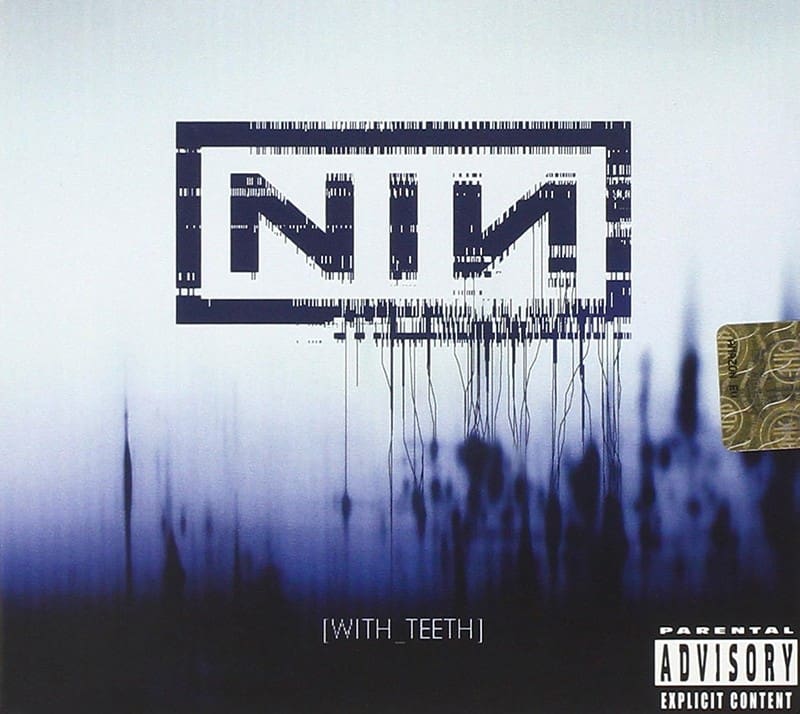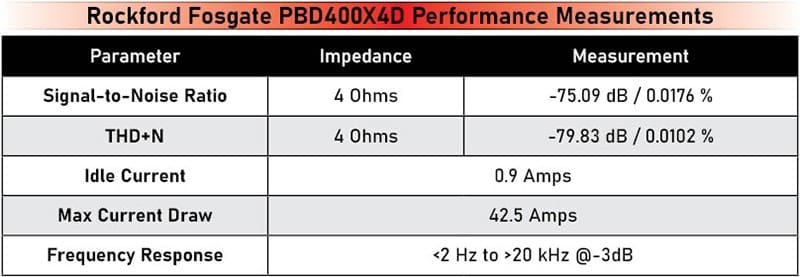If you are into car audio, then you know there are a lot of ultra-compact amplifiers on the market. Most of these solutions focus on size over anything. Knowing how Rockford Fosgate thinks, their four-channel PBR400X4 amplifier also delivers impressive power. Let’s check out the unique Boosted Rail design that offers impressive performance.
Feature and Specifications of the PBR400X4
The PBR400X4 is a four-channel amp rated to produce 50 watts of power into four four-ohm loads. Impressively, the amp can double its power to deliver 100 watts into four two-ohm loads. The amp is also bridgeable, providing 200 watts into a pair of four-ohm loads like subwoofers. No, that’s not earth-shattering power, but when you see the size of the amp, you’ll be impressed.
Physically, the amp is based on a three-part heatsink. The main chassis is a box-shaped aluminum extrusion that measures 5.5 inches. Cast aluminum end caps with integrated mounting feet give the amp some class and extend the total length to 6.75 inches. The amplifier’s width is 4.25 inches, and the height measures a mere 1.5 inches.
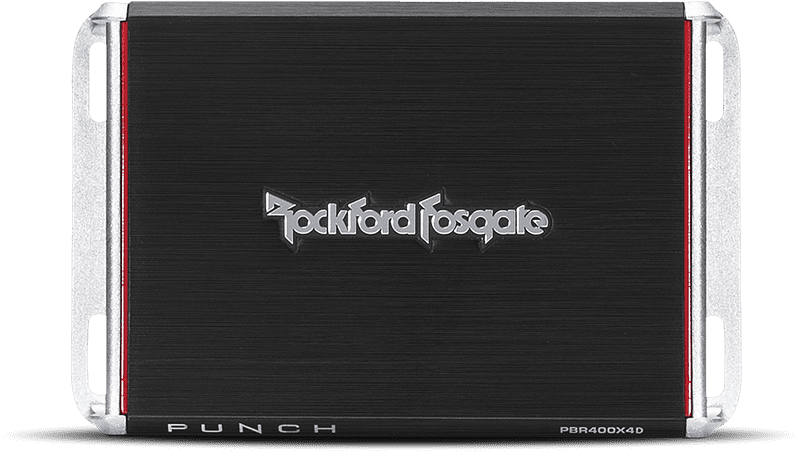
Signal and Power Connections
The right side of the amp houses two four-position plugs with 18-AWG wiring for speaker outputs and a larger three-position plug for power, ground, and remote turn-on connections. The power plug can accept 8-AWG wiring. The end panel has an LED that illuminates blue when the amp turns on. The end-panel LED will turn red if the amplifier detects an abnormal operating condition.
The left side of the amp has two more Molex-style four-position plugs for the included RCA inputs. If you use speaker-level signals, the RCA ends can be removed, and the wires connected to the speaker wires. The amp will make full power from signals between 150 millivolts and 12 volts RMS. As such, most systems do not need a high-level input adapter. Further, the amp has a built-in DC offset remote turn-on detection circuitry. When connected to a BTL amplifier like you’d find in a standard car radio, the amp will turn itself on automatically when the radio turns on.
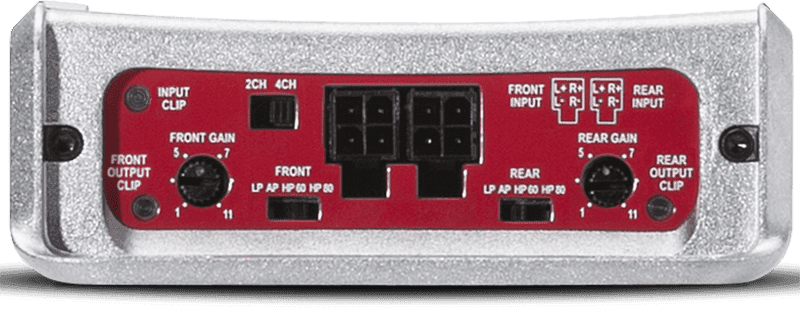
Power and Speaker Connections
Power and ground connections are made via a three-pin connector that plugs into the end of the amp. The power and ground terminals will accept freshly stripped 8-AWG power wire. The third connector is for the remote turn-on input wire.
Two four-pin connectors on the same end panel serve as the speaker outputs. The wire colors match the ISO standards of white, grey, green, and violet. The wires are 18-AWG in size.
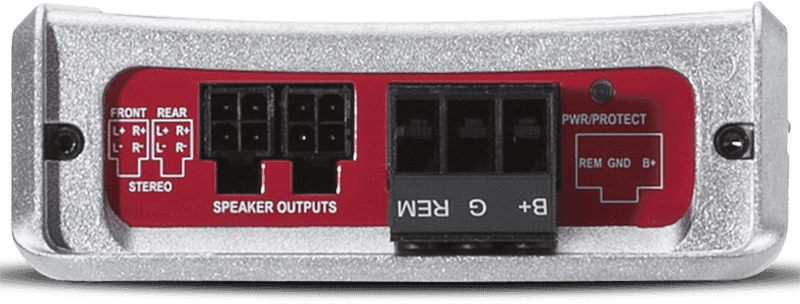
Signal Processing and Integration Features
Signal processing-wise, the amp has a four-position switch for each pair of channels. Your installer can select between a low-pass filter with an 80-hertz crossover point, a high-pass filter with 60 or 80-hertz crossover points, or an all-pass operation. Rockford Fosgate has included dedicated input and output clipping indicators for each pair of channels. These features make setup quick and easy in almost any system. There is also a 2-channel/4-channel input switch. When set to 2-channel mode, the signal on the front inputs is copied to the rear channels for amplification.
Rounding out the specifications, the amp is rated to produce audio with a functional bandwidth of 20 Hz to 20 kHz. It has a CTA-2006-compliant signal-to-noise ratio of 80 dB and channel separation of greater than 50 dB. Finally, the common-mode rejection ratio on the balanced inputs is specified as greater than 55 dB.
Rockford Fosgate Punch Boosted Rail Technology
Punch Boosted Rail Technology is Rockford Fosgate’s name for its proprietary switching voltage power supply solution. In a typical 50-watt per channel amp, the output device rail voltages would be set at roughly plus and minus 20 volts. In the case of the Boosted Rail design, when playing music at moderate volume levels, say below 25 watts, the rail voltages might only operate at plus and minus 10 volts. During this time, the heat energy produced by the output switching devices will be minimized. Put another way, the amp is more efficient than a design with a fixed rail voltage.
When there’s a sudden need for additional output voltages, the Punch Boosted Rail circuitry kicks in and doubles the rail voltages. With 40 volts peak-to-peak available, we get 50 watts of output power. The amp is unique because it uses capacitors to store the energy for the boost. Typical multi-voltage amplifiers use a secondary winding on the power supply transformer. This capacitor-boost design helps keep the amplifier compact while offering good efficiency. We’ll have to see how it fares on the test bench, but if Rockford Fosgate went through the trouble of creating and getting a patent on the circuit, it should have been worth the effort.
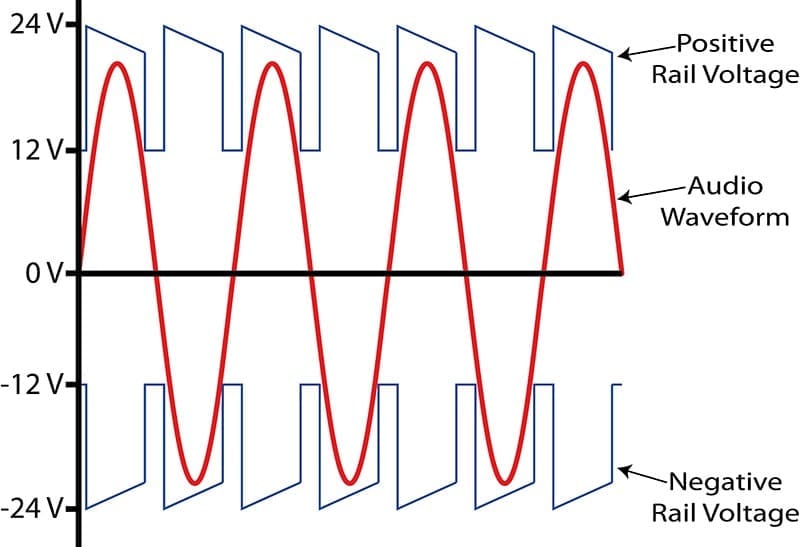
Listening Audition
Before heading to the test bench, I set the PBR400X4D up in the reference system and wired it so that one pair of channels drove bookshelf speakers. An older high-end, copper-chassis CD player served as the signal source for the evaluation.
The first track was “Right Where It Belongs” by Nine Inch Nails. It starts with a recording of a busy street with traffic in the background. This background was placed behind the instruments, acting almost like a curtain for the performance. The distorted guitar was well-positioned in the center of the soundstage, and Trent Reznor’s voice was panned well to the left. I noted that the top end of the muted piano was a bit forward in the presentation.
At 3:12 into the track, the bandwidth limiting on Reznor’s voice fades away, and he moves into the center with good focus. Overall, everything sounded well-controlled and clear. Next was “Higher Ground” by the Red Hot Chili Peppers. Kiedis’ voice was locked into the center of the soundstage and didn’t wander with frequency. The distorted guitar had a nice edge to it, thanks to the forwardness of the top end.
“Fishies” by The Cat Empire was next on the CD. The volume got cranked a bit for this one. The percussion remained reasonably tight. It’s not like what a full-size Punch or Power Series amp would deliver, but it’s better than most of the compact amps I’ve auditioned. There was a bit of emphasis on the top end of the lead vocal.

Last but certainly not least was “Das Spiegel” by The Chemical Brothers. The volume was cranked up another good amount for this one, bringing the playback level into the mid-80 dB SPL range. The little PBR400X4D remained solidly composed. Nothing turned soft or sour, which might indicate power delivery problems or excessive harmonic distortion.
Most compact amplifiers suffer in terms of dynamics due to limited energy storage on the small chassis. In short, those small solutions don’t have much room for many capacitors. The Rockford Fosgate PBR400X4D held its own in all regards, even at high volume levels. There was a little sizzle to the top end, but nothing that would be considered harsh.
Bench Testing the Rockford Fosgate PBR400X4D
With the listening done, it was time to head next door to the test bench and make some performance measurements. I started by quantifying the amplifier’s distortion characteristics. Into four four-ohm loads, the amp added about 0.010% THD+N at 1 watt of output. This is quite good for a compact amp. The signal-to-noise ratio was also good at about -75 dBV, which is impressive.
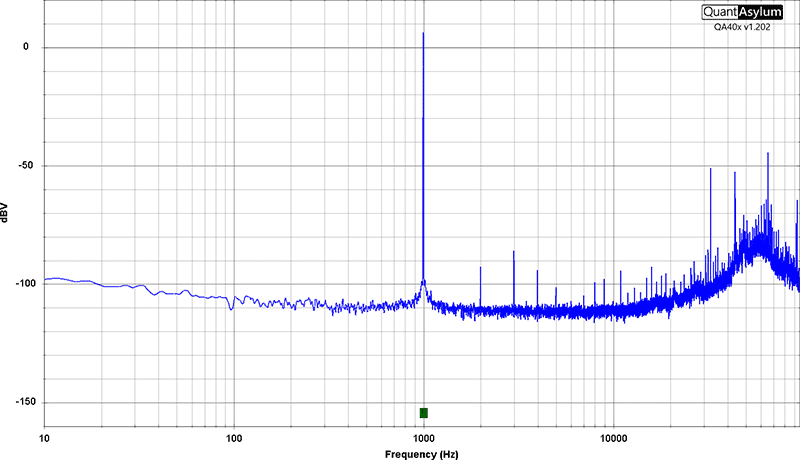
Next, I looked at the amplifier’s frequency response. The amp has a shallow roll-off on the bottom end, down about 1 dB at around 6 hertz. On the top end, there is a healthy resonant spike from the Class-D output filters. This tamed a bit when driving a two-ohm load, which likely added to the top end.
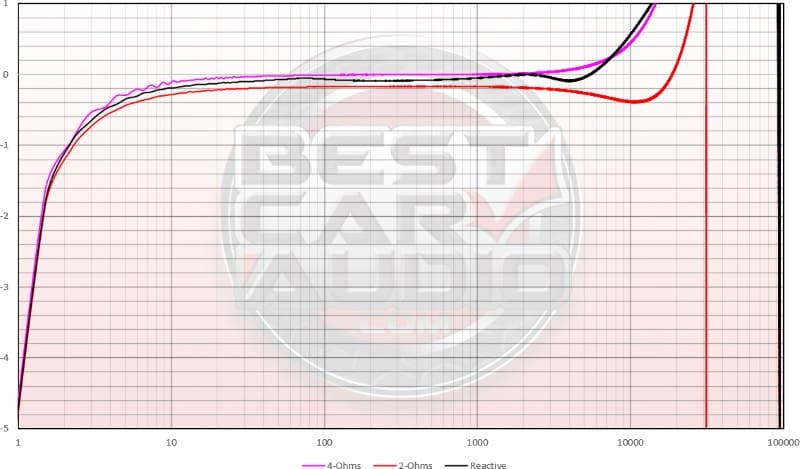
Output regulation into different loads was good, with the amp reducing its output by less than 0.2 dB when the load dropped from four to two ohms. There was less than 0.1 dB of variance when driving the simulated reactive load. Next, I checked the response of the built-in electronic crossovers. The 80-hertz high and low-pass filters are within a few hertz of being right at their target frequencies. The 60-hertz high-pass mode was also right on point. Nice work!
Channel separation was -75 dB through the midrange, dropping to about -60 dB at 20 kHz. This is very good and explains the excellent soundstage width and focus.
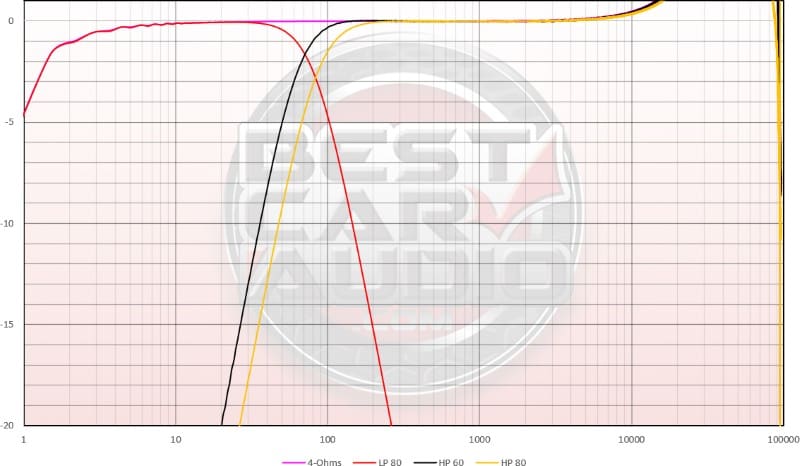
Last but certainly not least, I made a set of power measurements. The amp is rated to produce 50 watts of power per channel into four-ohm loads. I measured 71.4 watts per channel at 1% THD+N with the amp supplied with 14.4 volts. Next, I dropped the load impedance to two ohms per channel. The amp responded by delivering just shy of 130 watts into each load. Finally, I bridged the amp into a pair of four-ohm loads. The amp provided 260.8 watts of power to each.
Amplifier Efficiency
Efficiency is key to delivering big sound from a motorcycle or powersport application. These vehicles have alternators or stators rated for only 40 or 50 amps. As such, a power-hungry amplifier doesn’t work well in those applications. The PBR400X4D performed magnificently in terms of efficiency. The amp offered 88% efficiency at full power when driving four-ohm loads. At two-ohm loads and when bridged, it was still very efficient at 85%. These numbers are exceptional! This would be an outstanding choice if you wanted an amplifier for a boat that could deliver extended playtime, or for systems that have limited electrical systems like ultra-compact cars, golf carts, etc.
Conclusions on the Rockford Fosgate PBR400X4D Four-Channel Amplifier
There are a lot of compact amplifiers on the market these days. Manufacturers make bold claims about power, but only some seem to deliver on those claims. We’ve seen super-compact amps rated for over 100 watts per channel yet barely delivering 50. On the other end of the spectrum, the PBR400X4D over-delivers by about 30% on all its ratings. Better yet, the amp is reliable. We could play it at full rated power into two four-ohm loads for an impressive 11 minutes. Those other amps can barely last 160 seconds.
Combine this efficiency and power with rock-solid audio performance and all the features your installer needs to integrate this amp into your vehicle, and you have a winner. Oh, and the 28.7-square-inch footprint is just icing on the cake.
If you are in the market for an efficient and compact amplifier that sounds very good, then drop by a local authorized Rockford Fosgate retailer today. You can find an authorized retailer by visiting their website and using the locator tool. Be sure to check out their Facebook, Instagram, and YouTube feeds and channel to stay up to date with their latest product releases.

